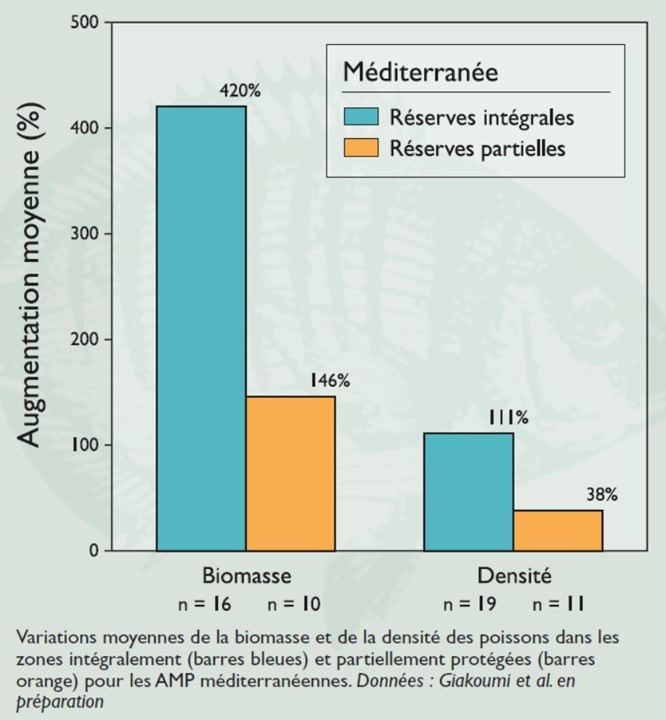
Continuation of the study of the reserve effect (2019 campaign)
Marine Protected Areas
Most Mediterranean countries have set up marine protected areas (MPAs) in their territorial waters as tools for preserving biodiversity. The majority are multiple use areas comprising one or more integral or partially protected areas. In integral areas, extractive activities are totally prohibited and certain recreational activities may be prohibited as well. In partially protected areas, extractive activities such as artisanal fishing may be authorized under certain conditions.
One of the objectives of MPAs is to preserve biodiversity, particularly in terms of abundance and diversity of species. This objective is generally achieved in properly monitored integral MPAs in the Mediterranean (graph). This is particularly true in biomass due to a greater number of fish and above all a greater size of individuals (therefore weight). In Monaco, the MPAs are also fully protected: article O.244-9 of the Code of the Sea stipulates that "all fishing, whatever the type, is prohibited in the MPAs of Larvotto and the drop-off of the Spelugues". In this context, and in order to guarantee this ban, the MPAs of Monaco benefit from a very high level of surveillance. This is ensured by the Services de l’Etat (Direction de la Sûreté Publique et en particulier la Division de Police Maritime et Aéroportuaire, Direction des Affaires Maritimes) and the AMPN in its capacity as manager of the MPAs. Although located in an urban environment, the MPAs of Monaco, fully protected and very closely monitored, should therefore present a reserve effect identical to that observed elsewhere in the Mediterranean when these two criteria (integral protection and monitoring) are present.
In order to check whether Monaco's MPAs effectively preserve fish populations, monitoring has been in place since 2016 in collaboration with the ECOSEAS laboratory (formerly ECOMERS) of the University of Nice Côte d'Azur. Their objective is to validate the hypothesis that the biomass and density of fish populations are significantly higher inside the Larvotto MPA than outside.
To do this, data is collected on sites offering similar habitats (presence of Posidonia meadows or riprap) between Menton and Beaulieu-sur-Mer. It is indeed important not to be limited to Monaco in order to have unprotected control sites. Counts are made by scuba diving using visual counts along transects: for the Posidonia meadow 10 transects 20 meters long by 2 meters wide and for the rockfill 6 transects 20 meters long by 5 meters wide. The counts are carried out species by species, distinguishing 3 size categories (small, medium, large) in order to be able to calculate the biomass from the number of individuals (density). Biomass is an important parameter to consider in order to assess the ecological "weight" of a species, and therefore its role in the fish population. The analysis of these parameters (density, biomass, species richness) can be done for the entire population (in reality all the species observed while diving) or for a specific group of species. It is therefore particularly interesting to look at the predators at the end of the food chain (grouper, barracuda for example). The biomass importance of high trophic level predators is a very clear indicator of the effectiveness of a protected area, recognized by the scientific community.
Finally, to take into account the natural variability of fish populations, 2 stations are considered at each site; for a given habitat. For example, for riprap (dikes), two stations are sampled west of Monaco (Beaulieu-sur-Mer and Saint-Jean-Cap Ferrat dikes), two in Monaco (Larvotto and Sporting East dikes) and finally two others to the east of Monaco (dykes of Menton 1 and Menton 2). A reserve effect will be observed if, on average, the parameters calculated in Monaco (density, biomass or species richness) are higher than those measured in the West or East, outside the protected area. This sampling protocol may seem a little cumbersome, but any study considering only one site per station or not taking into account control stations does not make it possible to affirm that a reserve effect exists or not.
The 2019 monitoring has just been completed and the data is still being analyzed. However, the first results of 2019 seem to confirm what has been observed previously; the biomass is much higher in Monaco than elsewhere in rocky environments (the densities are however not very different). These high biomasses in Monaco are due to the presence of large individuals, almost absent elsewhere. In rocky environments, high trophic level predators are particularly very well represented in Monaco (22 to 25% of total stand biomass) compared to unprotected areas to the east or west (< 1%). In the Posidonia meadow, the differences are not very marked between Monaco and the other sectors, in density, biomass and specific richness. This is due to the presence of numerous high trophic level predators in Monaco in rocky environments which will most likely feed on the seagrass, thus reducing the density or biomass of fish populations. Comparable results have been observed in other Mediterranean MPAs (Scandola, Tavolara, etc.).
The Larvotto reserve offers both shelter (dikes) and food (seagrass) to high trophic level predators. The reserve therefore works well and thus fulfills its role. The maintenance of this functioning (effective MPA) is therefore linked to 3 factors: (i) the maintenance of an undegraded and complex habitat (dikes), (ii) the presence of a meadow in good condition, nearby, providing food and (iii) the maintenance of the absence of fishing and strong surveillance.
